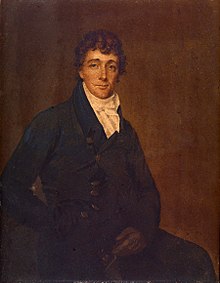Francis Scott Key | |
|---|---|
 Key c. 1825 | |
| 4th United States Attorney for the District of Columbia | |
| In office 1833–1841 | |
| President | |
| Preceded by | Thomas Swann |
| Succeeded by | Philip Richard Fendall II |
| Personal details | |
| Born | August 1, 1779 Frederick County, Maryland (now Carroll County) |
| Died | January 11, 1843 (aged 63) Baltimore, Maryland, U.S. |
| Resting place | Mt. Olivet Cemetery |
| Spouse |
Mary Tayloe Lloyd (m. 1802) |
| Children | 11,[1] including Philip |
| Relatives |
|
| Occupation |
|
Francis Scott Key (August 1, 1779 – January 11, 1843)[3] was an American lawyer, author, and poet from Frederick, Maryland, best known as the author of the text of the American national anthem "The Star-Spangled Banner".[4] Key observed the British bombardment of Fort McHenry in 1814 during the War of 1812. He was inspired upon seeing the American flag still flying over the fort at dawn and wrote the poem "Defence of Fort M'Henry"; it was published within a week with the suggested tune of the popular song "To Anacreon in Heaven". The song with Key's lyrics became known as "The Star-Spangled Banner" and slowly gained in popularity as an unofficial anthem, finally achieving official status as the national anthem more than a century later under President Herbert Hoover.
Key was a lawyer in Maryland and Washington, D.C. for four decades and worked on important cases, including the Burr conspiracy trial, and he argued numerous times before the Supreme Court. He was nominated for District Attorney for the District of Columbia by President Andrew Jackson, where he served from 1833 to 1841. He was a devout Episcopalian.
Key owned slaves from 1800, during which time abolitionists ridiculed his words, claiming that America was more like the "Land of the Free and Home of the Oppressed".[5] As District Attorney, he suppressed abolitionists, and he lost a case against Reuben Crandall in 1836 where he accused the defendant's abolitionist publications of instigating slaves to rebel. He was also a leader of the American Colonization Society which sent former slaves to Africa.[6][7] He freed some of his slaves in the 1830s, paying one as his farm foreman to supervise his other slaves.[8] He publicly criticized slavery and gave free legal representation to some slaves seeking freedom, but he also represented owners of runaway slaves. He had eight slaves at the time of his death.[9]
- ^ Leepson, Marc, What so Proudly We Hailed: Francis Scott Key, a life (Palgrave Macmillan, 2014), Appendix A, p. 202
- ^ "'Star Spangled Banner,' Key and Chief Justice Taney – Did Taney Make a Pre-Nuptial Agreement with His Wife?". The American Catholic Historical Researches. 8 (1). American Catholic Historical Society: 87–90. January 1912. JSTOR 44375033. Retrieved August 1, 2022 – via JSTOR.
- ^ Penton, Kemberly (September 14, 2016). "Remembering Francis Scott Key: The Man Behind America's National Anthem 'The Star-Spangled Banner'". Hall of Fame. Archived from the original on October 19, 2016. Retrieved October 16, 2018.
- ^ Lineberry, Cate (March 1, 2007). "The Story Behind the Star Spangled Banner". Smithsonian. Retrieved June 20, 2020.
- ^ "Where's the Debate on Francis Scott Key's Slave-Holding Legacy?". Smithsonian. Retrieved August 13, 2018.
- ^ "The unexpected connection between slavery, NFL protests and the national anthem". CNN. Retrieved August 9, 2018.
- ^ "Francis Scott Key's life was a lot more complicated than just writing The Star-Spangled Banner". The Washington Examiner. Retrieved August 9, 2018.
- ^ Cite error: The named reference
Leepsonwas invoked but never defined (see the help page). - ^ Cite error: The named reference
UNCPwas invoked but never defined (see the help page).